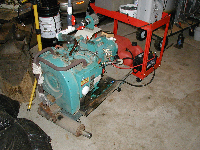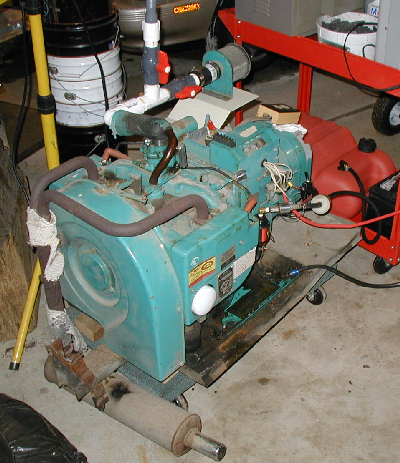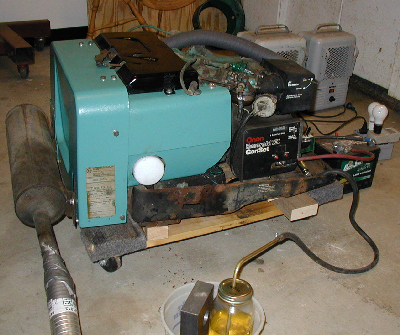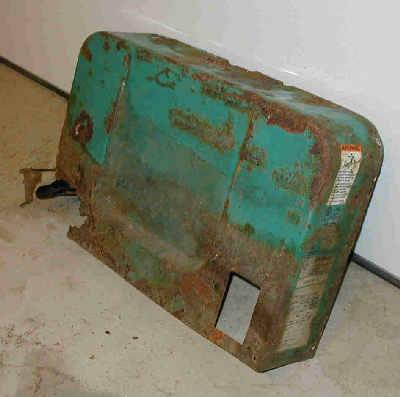



During the last half of 2009 I bought 2 used Onan RV-type gensets to use for experimenting with woodgas as a fuel source. You can click the "My Woodgas Page" link, above to see what I am doing with woodgas at present.
Early on, I bought CD's containing manuals for MY gensets from a company that sells them on E-Bay. They have some value, but in neither case did their content fit exactly the genset for which I bought it. Serious googling and begging has filled almost all of the gaps.
The first one was a 6.5NH3CR, spec J. I paid $300 for it.
 You can see that I have repositioned the air cleaner and added the white woodgas supply manifold to the one.
You can see that I have repositioned the air cleaner and added the white woodgas supply manifold to the one.
The seller told me that this one was running when they removed it, but I really doubt it. There was a glob of rust in one
cylinder and the choke shaft had been broken off when something heavy had been dropped on the choke heater.
I removed both
heads, and cleaned out the rust, rehoning that area and freeing the valves.
I removed the broken off choke shaft, cleaned up the area where it broke, drilled and tapped the broken parts to 4-40, inserted
a piece of 4-40 treaded rod to assure alignment and brazed it back together. Works fine. I did buy a replacement choke heater
housing and bimetal spring on E-bay, but, since I am going to use this genset in a fully attended mode, I just put a manual
lever on the choke shaft--- for now, anyway.
I tried to start it. I thought I'd try to start it on
ether before starting to spend money on the machine. It fired right up on the ether, thank goodness!
As soon as I heard it run, I changed oil and filter. Later, after running it for an hour or two, I changed both oil and
filter again, just to make sure it was clean inside.
But when I plumbed in a quart jar as a fuel tank, I quickly discovered that the fuel pump was bad.
That's when I started learning how expensive parts are from Cummins/Onan and its dealers.
During this time, I was googling around for manuals and other information. I did find some helpful information. The first thing I learned was that it is real difficult to figure out what's actually inside the machine. Onan sure did make a lot of different versions of any given model.
The next issue was to get the genset to run long enough to see if I could make power. Even though the fuel pump worked,
the carburetor was clogged up enough that I had to run on almost full choke to keep the engine going, even with the main jet
several turns open.. But that was enough so I could see that it did, indeed, generate power.
I didn't look forward to tearing down the carburetor, so I poured several ounces of Sea-Foam into my one quart "glass tank",
filled it the rest of the way with gasoline and started it up. I ran that fuel through, again almost completely choking
the engine with my hand. There was no change. I loaded the jar up again with several ounces of Sea-Foam and some gasoline
and ran it again. About half way through that run, the engine just quit. The main jet had cleared itself and flooded the
engine. I screwed it down to only about 1 1/2 turns open and it now starts and runs well.
The second one was a 6.5NHEAF spec D. I paid $200 for that one.

This one was extremely rusty and otherwise corroded.
The seller of this one said it had been given to him by a guy who took it out of his motorhome because it had quit generating.
We cranked it over by hand and it did, at least, have good compression. But it must have lived most of its life in the
rust belt, because the sheet metal was rusted very badly.

Not only that, but many of the bolts and screws holding parts onto the engine were corroded deeply. Corrosion had also
gotten into the generator's control box area, corroding some parts of the circuit board, the starting solenoid and other
parts.
The engine could not have been running at all because the rear starter bearing had broken allowing the armature to jump
around and smash some of the permanent magnets in the field area. The starter solenoid was shot and the fuel pump
was so rusted that you could hardly tell what it was supposed to be. I had to cut the original metal fuel line
off because it was so rusty. All the carburetor adjustment screws and shafts were stuck.
Once all those parts were in place, I tried to fire it up, but no cigar. Dead.
Now on to the control board. Well, first, I needed a schematic for the machine. What a problem! This machine is a
"Spec D" unit. This means that it is about the first NH unit to have an electronic regulator. It had a control board
with 3 plugs on it when it was manufactured back in 1988. But, in about 1993, someone replaced that control board with
a later model board that has only 2 jacks. This board was part of a "kit" which included a new wiring harness that changed
the actual wiring a lot. This really complicated troubleshooting. It took me a long time to even realize that the
foregoing modification had occurred!
Once I had a general idea about what was going on, I found that the Start-Stop switch on the control board was bad.
2 problems there: First, the board had been coated with a heavy varnish to minimize corrosion. This makes it hard to even
test probe, let alone unsolder and replace components on the board. Second, I couldn't find an exact replacement switch.
So, I replaced the Start-Stop switch with two small momentary push buttons that I mounted off-board, to the front plastic
panel, right beside the silk screened words "Start" and Stop".

Still no cranking action! Back to the control board. By now I had determined that relay K2 had to pull in before
anything could happen. I found that corrosion had eaten into the board foils where one K2 coil contact came through.
I had to dig deeply into the substrate to find enough K2 coil lead to solder to and then added a short strand of wire to
reconnect it to the foil.
.
Success! The engine would finally crank! So I squirt in some ether and WOW!, it runs. But---
Now I have the old "Engine Starts Up, but Dies as soon as the start switch is released" problem.
Next thing I did was to replace oil and filter.
By this time, I had removed the carburetor, disassembled and cleaned it, reinstalled it while leaving off most of the
extra stuff, like the choke heater, vacuum pull-off, air cleaner assembly, etc.. So, I hooked an analog voltmeter to the
the choke heater leads (which ARE the B1-B2 generator terminals) so I could see if the machine was generating power to
run its own control circuits.
I could see no voltage at that point as I ran the engine on ether.
Next I assumed that there must be no field current, so I opened the generator brush cover to check out the slip rings.
On this unit, the rotor is the field and all the outputs are taken from the stator, so the rotor has only 2 slip rings.
I found that the stranded leads to the brushes were almost corroded through, but they were still making contact, so removed
them so I could look at the slip rings. The slip rings were so corroded they looked all white! I cleaned them up fairly
well with fine abrasive paper, enough that they were shiny in most places. I measured the rotor resistance and it was
okay at about 21 ohms. Replaced the brushes after lightly sanding them with a correctly sized dowel and sandpaper.
Ether again, engine starts up, but still quits when you let up on the start switch. This time, however, I see a little
wiggle on the meter connected to B1-B2 (at the choke heater). Upon looking at the voltage regulator (VR1)connector, I found
one connection that was badly scorched, so I wired around it. No change.
After doing a lot of research, finally finding the really
great Onan Forum at Smokstak.com, and after trying a lot of things, none of which worked, I finally decided to go back
to the slip rings again. I had already connected a dc ammeter in series with the field leads and hadn't seen any appreciable
current flow. So now, I connected an ohmmeter across the brushes (field leads disconnected, of course). I found that
I still had the 21 ohms across the field, as long as the generator was at rest. BUT if I turned the engine over, the
resistance became erratic and high. Aha! I removed the brushes again, made a special little paddle to which I could
attach my sandpaper. I applied the paddle to the slip rings with the engine running on ether, several squirts worth.
This gave me totally shiny and much smoother slip rings. Upon reinstalling the brushes, one brush holder came apart due
to corrosion on one tiny (tinier than I have ever seen) pop rivet. I fixed that with a 2-56 screw and nut.
I have since installed brand new brushes.
At this point, the machine was running and generating power, but it would begin to stumble and hunt a minute or so after
startup. I first thought it was a clogged main jet, but that didn't make sense since it started up just fine. I gave it
a couple of treatments of Sea-Foam as I had done with the 6.4NH3CR, but no help.
Finally, I just started twisting the idle jet open, and, after opening it about 2 full turns, the engine smoothed right out!
Who'da thunk it?
Now its time to clean up the sheet metal. The "Scroll" (main cooling shroud) was rusted so bad that parts of it were gone
so I made a new section as needed and pop riveted it in place. I sanded and sanded and
Electrolytically Derusted
the major sheet metal parts. A lot of metal had just gone away, so the result isn't the greatest.
But I had many many stuck and broken of bolts and screws to deal with there, too.
By the time I had gotten into it this deep, I even put up my own webpage about
Removing Stuck Bolts.
I read a post on Smokstak where a guy bought "Lincoln Green" Kilz-based paint at Walmart to repaint his Onan so, as I didn't want
to wait for an expensive Onan Green spray bomb, I bought a quart. It is exterior house paint, not high temp engine paint.
We will see how it works. I found that it wouldn't stick to the parts, so after scraping and sanding of my first attempt,
I spray bombed the parts with a green enamel first. That seems to work well as a primer.
For the "Noise Cover", I used a black spray bomb primer, then semi gloss black enamel. It's a so-so job, but I'm in it for
function, not fancy.